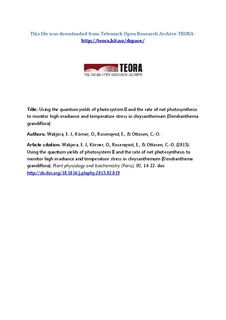| dc.identifier.citation | Janka, E., Körner, O., Rosenqvist, E., & Ottosen, C.-O. (2015). Using the quantum yields of photosystem II and the rate of net photosynthesis to monitor high irradiance and temperature stress in chrysanthemum (Dendranthema grandiflora). Plant Physiology and Biochemistry, 90, 14-22. | |
| dc.description.abstract | Under a dynamic greenhouse climate control regime, temperature is adjusted to optimise plant physiological responses to prevailing irradiance levels; thus, both temperature and irradiance are used by the plant to maximise the rate of photosynthesis, assuming other factors are not limiting. The control regime may be optimised by monitoring plant responses, and may be promptly adjusted when plant performance is affected by extreme microclimatic conditions, such as high irradiance or temperature. To determine the stress indicators of plants based on their physiological responses, net photosynthesis (Pn) and four chlorophyll-a fluorescence parameters: maximum photochemical efficiency of PSII [Fv/Fm], electron transport rate [ETR], PSII operating efficiency [F′q/F′m], and non-photochemical quenching [NPQ] were assessed for potted chrysanthemum (Dendranthema grandiflora Tzvelev) ‘Coral Charm’ under different temperature (20, 24, 28, 32, 36 °C) and daily light integrals (DLI; 11, 20, 31, and 43 mol m-2 created by a PAR of 171, 311, 485 and 667 μmol m-2 s-1 for 16 h). High irradiance (667 μmol m-2 s-1) combined with high temperature (>32 °C) significantly (p < 0.05) decreased Fv/Fm. Under high irradiance, the maximum Pn and ETR were reached at 24 °C. Increased irradiance decreased the PSII operating efficiency and increased NPQ, while both high irradiance and temperature had a significant effect on the PSII operating efficiency at temperatures >28 °C. Under high irradiance and temperature, changes in the NPQ determined the PSII operating efficiency, with no major change in the fraction of open PSII centres (qL) (indicating a QA redox state). We conclude that 1) chrysanthemum plants cope with excess irradiance by non-radiative dissipation or a reversible stress response, with the effect on the Pn and quantum yield of PSII remaining low until the temperature reaches 28 °C and 2) the integration of online measurements to monitor photosynthesis and PSII operating efficiency may be used to optimise dynamic greenhouse control regimes and to detect plant stress caused by extreme microclimatic conditions. | |
